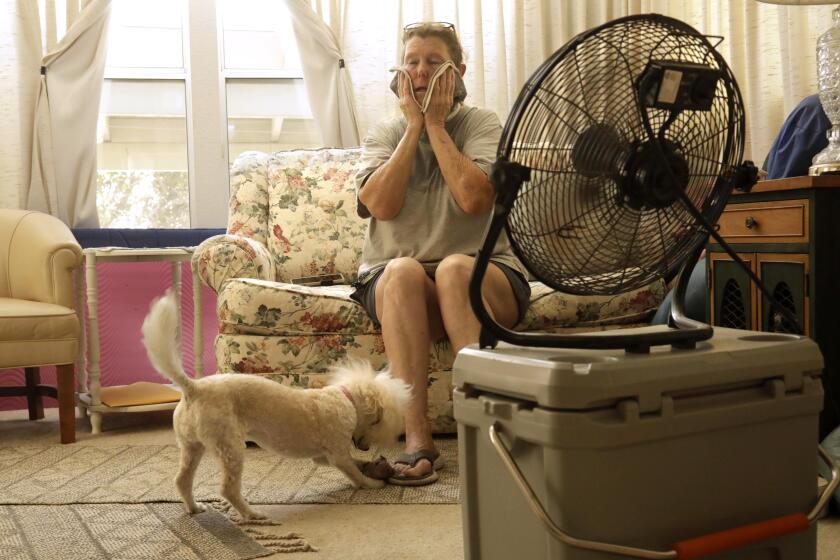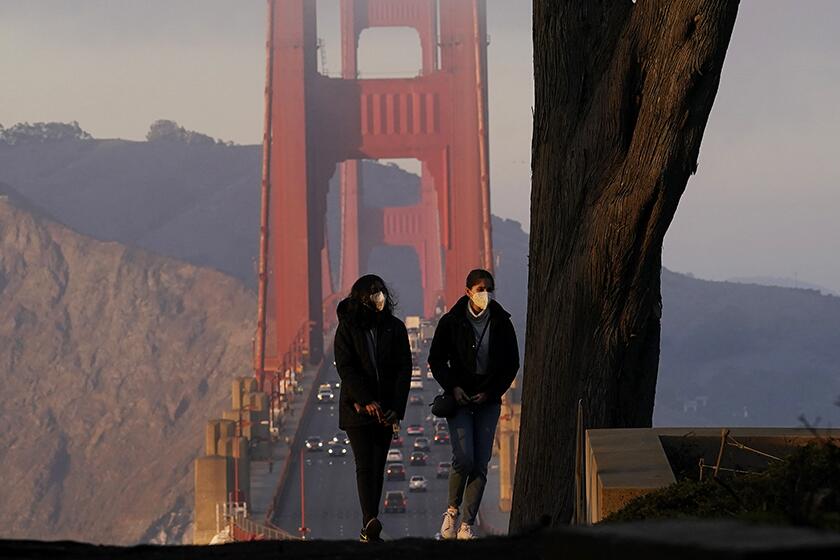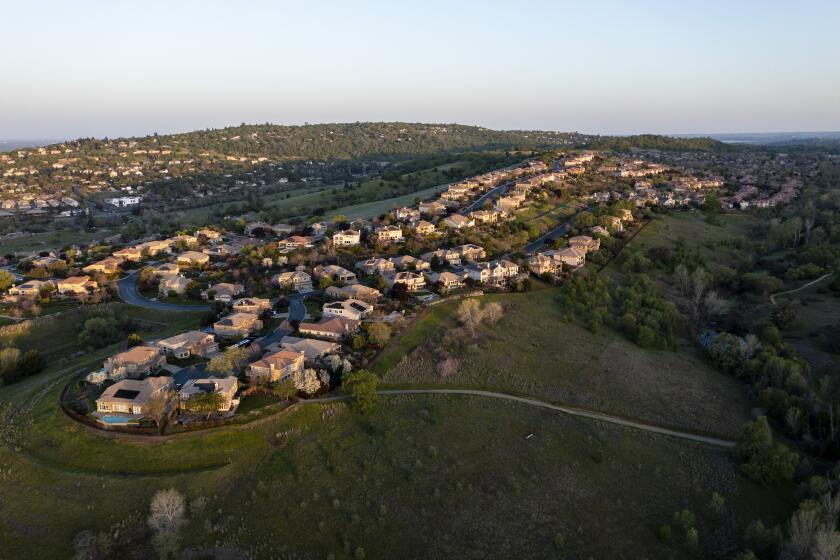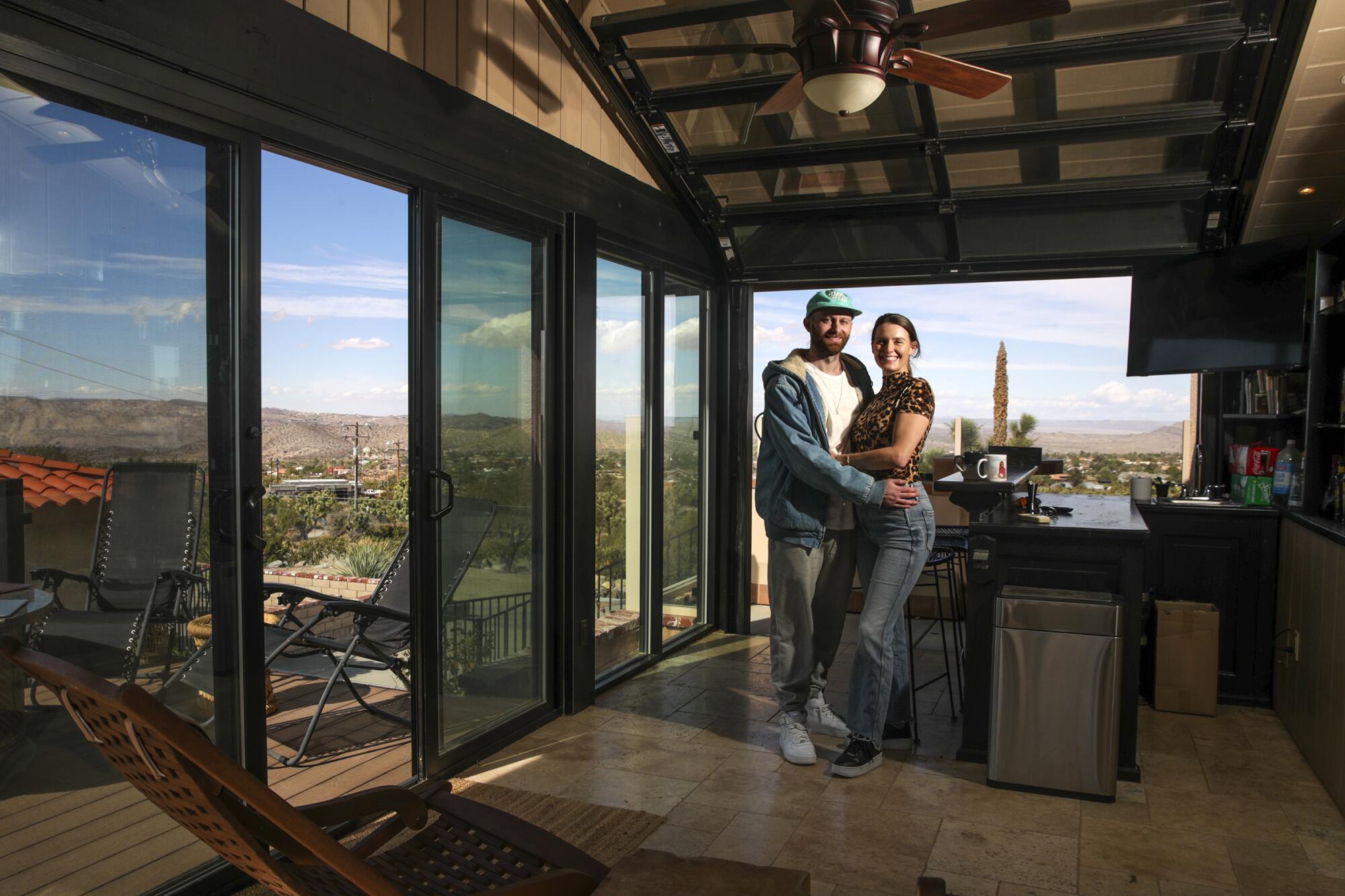
- Share via
YUCCA VALLEY, Calif. — Tyler Gaul strode across the sprawling backyard of his Yucca Valley home and surveyed the rocky hillside a few steps away from the pool and basketball court that sit atop his 2-acre property. When he first moved to the desert from Los Angeles last fall, this jagged landscape granted him a sense of serenity as the crowded city he left behind grappled with a pandemic.
Gaul, who runs his own skin care company, knew it was time to move when he could no longer exercise outside his Echo Park apartment — his respite from stay-at-home orders — because of wildfire smoke polluting the air. Constant and worsening wildfires, paired with a public health crisis, proved to be too much.
“I have a lung condition, and I was like, ‘No, I can’t do this anymore,’” he recalled.
So he set out for the desert.
Like many other city dwellers who have fled urban sprawl over the last year and a half, Gaul sought shelter in a more isolated desert community in hopes of finding more space and clean air, and limiting his exposure to the coronavirus. Local real estate agents say that the migration is driven by a desire for affordable housing and large plots of land, a move further propelled by the nation’s sudden shift toward teleworking.
Until last year, Gaul hadn’t seen himself as the desert type or thought of making an escape from the city. But since moving, he and his girlfriend have hosted pool parties for their friends living in the city; they’ve learned how to tackle home repairs, like the time there was an irrigation leak; they stood in stillness during their first desert winter and listened as the sound of snow falling off trees pelted the craggy ground below.
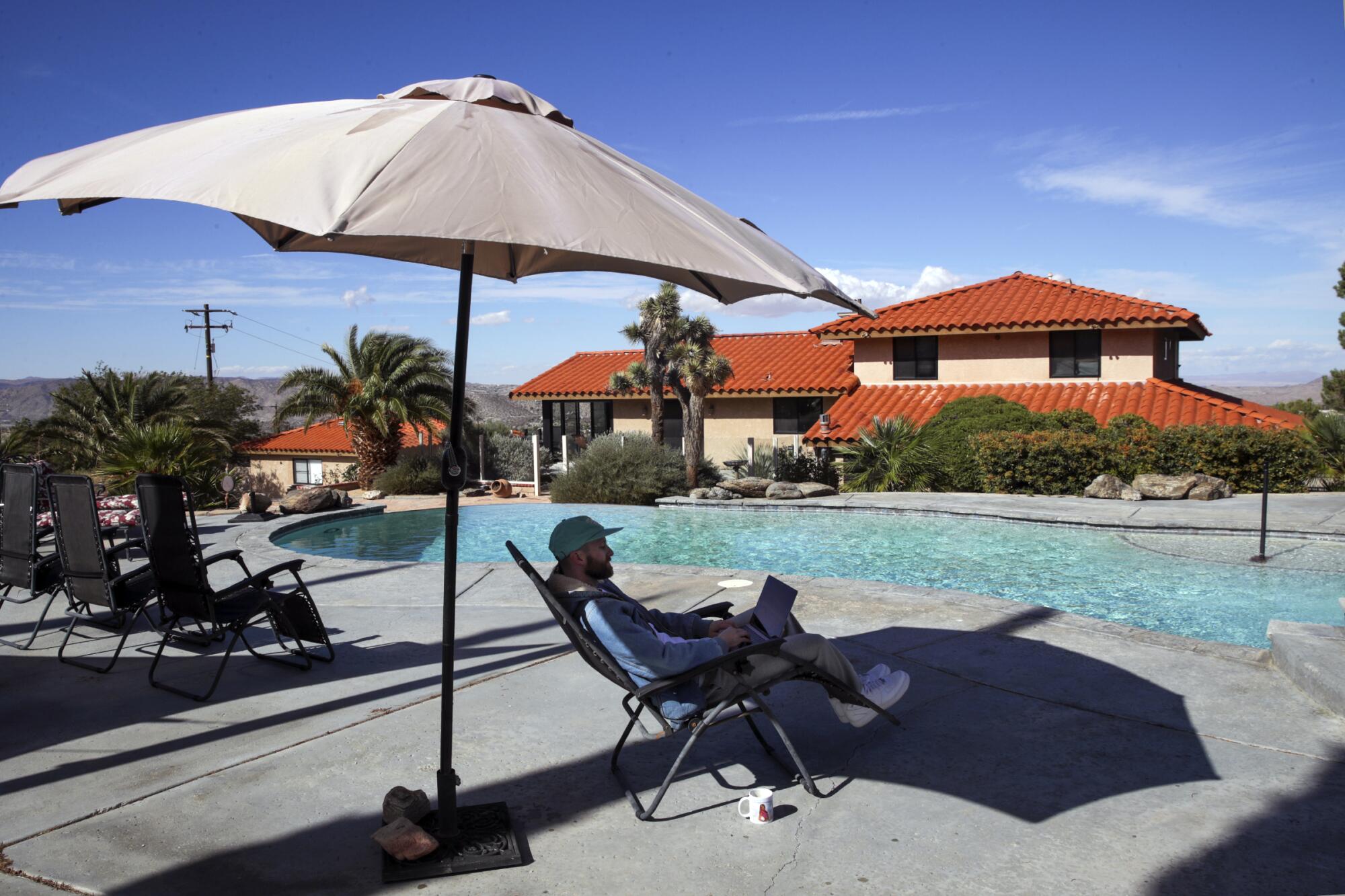
The Great California Migration
This is part of an occasional series of stories about Californians on the move, both to other states and within the Golden State. The state’s growth rate is the lowest in well over a century, and the pandemic has given many residents a further excuse to leave California’s big cities, which are among the most expensive places to live in the country.
“One day, we were in the pool and there was this huge owl, and it just like swept down and looked like a huge, silent airplane. It was just, like, so majestic,” Gaul, 35, said as he lifted a plastic cover to check for a tarantula that had recently been roaming the side of his home.
The high desert communities of Yucca Valley, Pioneertown and Joshua Tree about 130 miles east of Los Angeles have been inundated not only with new home buyers but also renters and city folk who come to work remotely at one of the many Airbnbs that have cropped up in recent years — sometimes to the chagrin of locals who could live without hearing the loud parties, or driving through the dust kicked up by Teslas plowing through dirt roads in a rush that those used to a slower pace of life have trouble understanding.
“It feels like the zeitgeist of the desert,” said Tom Murtagh, a Realtor in Twentynine Palms. “It’s a time of change. A lot of people here are having a tough time with it and I am very sympathetic. It’s a tough situation — gentrification reached the desert and it’s good and bad. There’s money to fix things, but it’s a double-edged sword.”
Although the pandemic accelerated migration to the high desert, the shift was gaining steam in the years before.
Jean Michel Alperin moved to Yucca Valley with his family in 2018. He and his wife, Sarah Scott Alperin, were disappointed with the lack of options in their price range in L.A. despite looking at homes in neighborhoods across the city. Jean Michel was on the brink of helping to revitalize and reopen Pioneertown’s Red Dog Saloon and had pondered making the commute to the desert a few days a week for work.
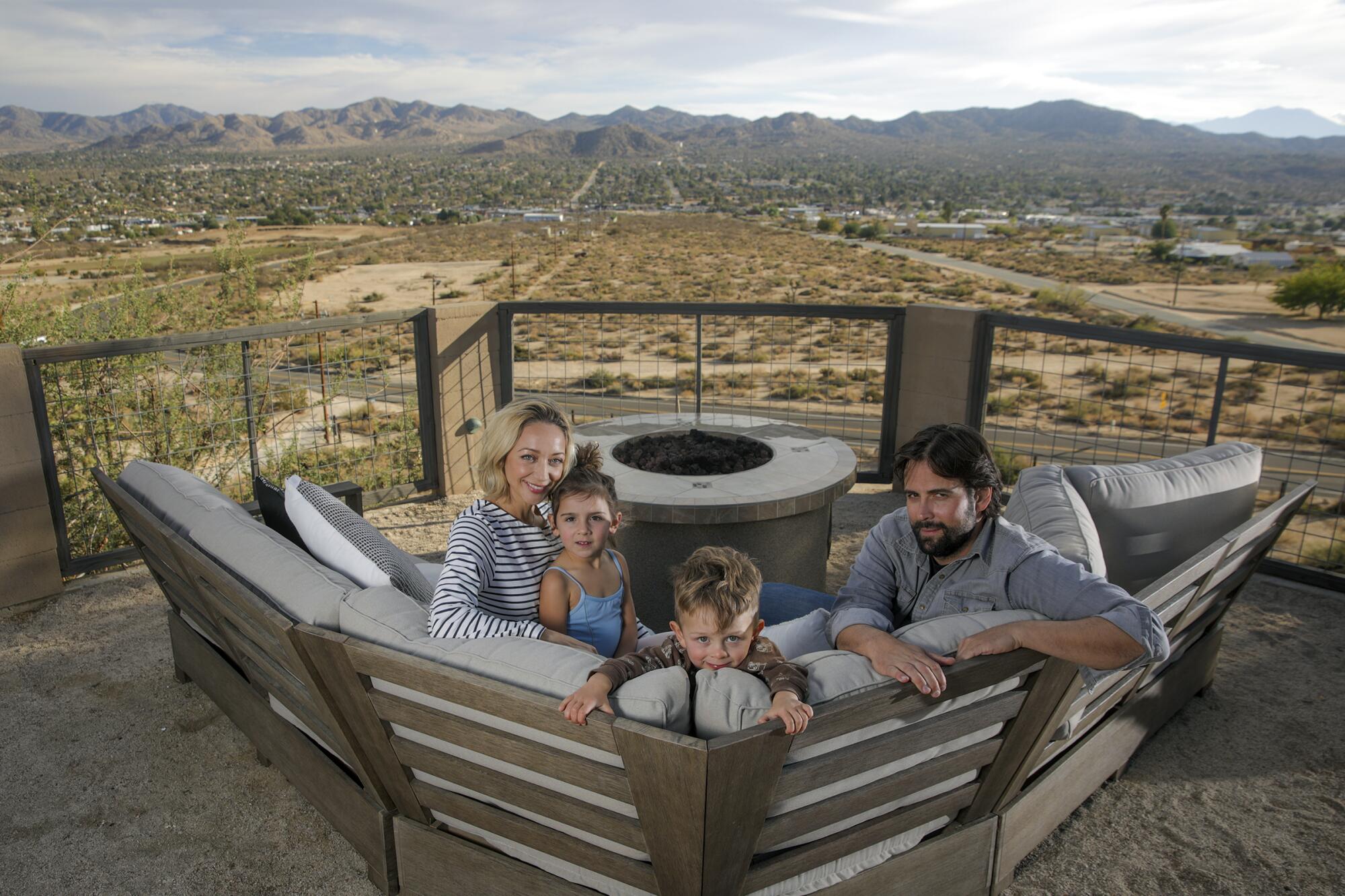
“While I was doing business here for a couple days I decided to see Realtors. We saw four places, and the fourth was the home that we bought. It was one of those dream homes. It seduced me in this very intimate way. Kind of like when you meet somebody, it was a romance,” Alperin, 40, said. “It was a total about-face. And it was tough, for sure. There’s a lot of differences moving from Echo Park to Yucca.”
Alperin said that he doesn’t necessarily miss the people he could meet in L.A. — he’s bonded with other transplants from Echo Park here in the desert — but he does miss the wealth of cafes filled with people poring over books.
“That’s kind of the feeling, that there’s just one place. You don’t have options,” he said. “But that’s part of coming out here. We’re all kind of frontier people.”
The surge of migration eastward fits a pattern of families escaping densely populated cities, a trend that dates back to the mid-20th century.
Three years in, he doesn’t regret the move. He and his wife have remodeled their roughly 2,000-square-foot home, whose picture windows and open floor plan sit on 5 acres, converting the garage to a studio and the barn to an office and “mini man cave.”
They’ve made friends with other young transplants who have children the same age as theirs and, in response to the pandemic, have joined a schooling pod where a Montessori teacher comes to instruct the kids. And the Red Dog reopened in August 2020.
Alperin sees the saloon as a job creator in town — he has about 30 employees, who by his estimate make about 25% more than the highest-paying kitchen jobs in the high desert with tips included.
It’s proof, in his eyes, that city transplants can do good in the community.
“At first, we felt like fish out of water,” he said. “That very quickly changed … we built a community. I would say we need to work on diversity. That’s where we’re lacking now. But it’s a good community of people that are from L.A., and like-minded. And we’re starting to integrate community as well, which is nice.”
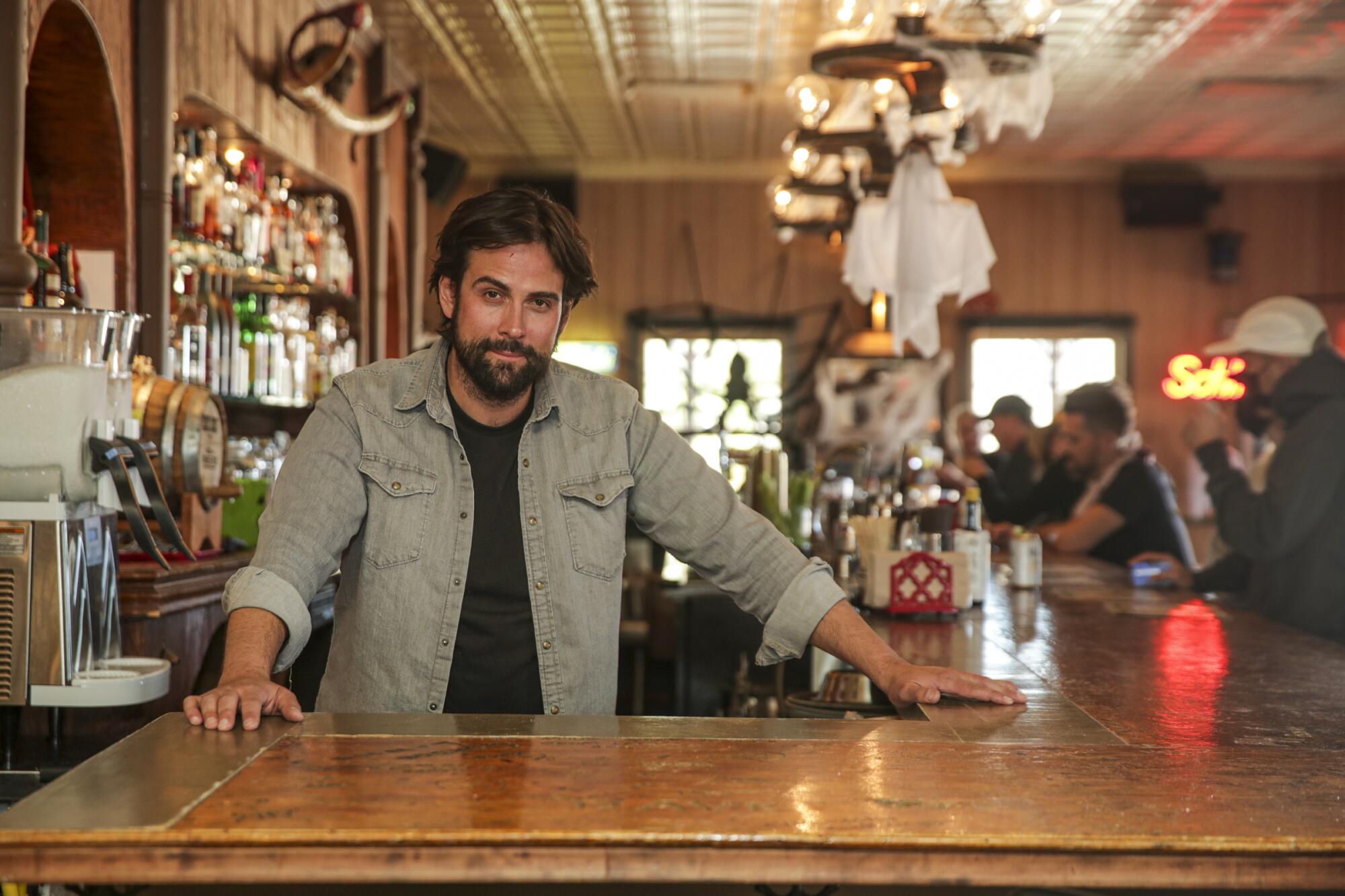
Sarah Scott Alperin, an intimacy coordinator who assists TV and film productions in safely filming intimate scenes and who commutes to L.A. for work, said the couple moved just as others from Los Angeles began packing their bags. They watched as Angelenos moved from Echo Park, Silver Lake and parts of the Eastside, and then witnessed the migration turn into a “mad rush” during the pandemic.
Subscribers get early access to this story
We’re offering L.A. Times subscribers first access to our best journalism. Thank you for your support.
But life in the desert doesn’t always measure up to the Instagram desert-chic aesthetic of playing guitar by a fire pit at a trendy bungalow or swinging in a hammock against a backdrop of Joshua trees. Last summer, Joshua Tree reached a sweltering 114 degrees; Morongo Valley hit 108.
“The cold, the heat, the bitter dryness — it’s on the extreme,” Sarah, 42, said. “There was a week where our 4-year-old said, ‘Mom wants to move back,’ because it was so freaking hot and unbearable and you can’t go out. Or you’re hungry one day, and there’s nothing around. Shopping is minimal.”
California chronically undercounts the death toll from extreme heat, which disproportionately harms the poor, the elderly and others who are vulnerable.
And sometimes, locals can be unwelcoming.
“We drive a Prius and we took off the Santa Monica license plate frame. We’ve heard, ‘Go back to L.A.,’” she said.
Last Sunday, she said, the family hosted a potluck for other young couples with children, part of a new roving tradition shared by the roughly 25 moms in a chat group she belongs to.
“There were roughly 40 adults and 20-something kids here and it was like the most joyful thing in the world, but it’s funny because we are all transplants,” she said. “There was one couple who has a newborn and have been out here at least a decade. We want to be inclusive because we know what it’s like to move here and not know anybody.”
A new report from the nonpartisan California Policy Lab also found that fewer people are moving to the Golden State.
But one family’s inclusion may mean another struggling to buy a home. Some low-income residents here are being priced out of the market, with the resulting community frictions often playing out on social media, Murtagh, the Realtor, said. The problem, he added, is that there is not enough multifamily housing in the desert.
“Rents are going up dramatically,” he said. “It’s cheap for L.A. but a lot higher than compared to two years ago.”
The housing market looks a little different, however. After a large wave of buyers came to town, home prices have started to cool in recent months, said Merl Abel, the mayor of Yucca Valley and a Realtor in the area.
“Some of the frustration of people a few months ago was getting outbid every time they put in an offer. Now people have an opportunity. We’re seeing offers of one or two per home, unless it’s underpriced,” he said. “The fever pitch has sort of leveled off a bit.”
The cost of a home in Yucca Valley has risen sharply in the last year, according to data from Zillow. In August 2021, the “typical home value” in Yucca Valley was $314,858 — an increase of nearly 31% since August 2020, data show. In Joshua Tree, home values have gone up 40.2% over the last year, according to Zillow.
Vacation destinations have become primary homes during the COVID-19 pandemic as Lake Tahoe and Palm Springs see surges in population and housing costs.
The wave of newcomers over the last few years has also brought a sense of revitalization to the area, Abel added.
“In Old Town Yucca Valley, we have had young people come and open up businesses,” he said. “There’s a boutique with organic wine and cheese and things like that where people can make a basket and go to the national park. Next to that, they opened a yoga studio. That strip has transformed.”
Danny Sall, a builder born and raised in Pipes Canyon in the Pioneertown area, said that he’s “receptive” to people moving in from the city, but he finds loud visitors disruptive. He also worries that the cost of housing might become prohibitive to locals hoping to buy, or that the quick jump in real estate prices will give longtime residents an incentive to sell off what they have and leave.
“It’s changing the demographics a little bit,” Sall, 72, said. “The younger, upper-middle-class hipster from L.A. buys the place, and the old guy with the horse and wife that went out riding two or three times a week are selling out because the price is so high.”
Sall grew up on a homestead beside the Pioneertown of old, born just three years after the jumbled boulders and blue skies straight out of a western movie lured the likes of Roy Rogers, Gene Autry and other Hollywood cowboys. The first buildings were fully functional businesses, including a motel, an ice cream parlor, a shooting gallery and the Red Dog Saloon, according to Pioneertown’s website.
“I’ve been expecting it for years,” Sall said of the boom in short-term rentals and buyers from the city. “Pioneertown has been our best-kept secret.”
One of his biggest concerns, he said, is new transplants “changing the look of the place” by building homes bounded by white fences to match the “stark white” paint on their houses.
“I always built my houses with a roofline that is gray-brown and wood siding that is neutral and blends with the surroundings. They like the house to stand out. They make it contrast with the landscape,” he said. “They don’t know any better. If you can talk to them and convince them to not change it so much, it’s good.”
Sall, who lives off a dirt road just outside Pioneertown, said that the latest wave of newcomers is the biggest he’s seen in his seven decades living in the desert.
“I don’t know where it will end. People keep coming and spending more money,” he said. But, having lived here so long, Sall said he’d “have to hate everybody in town” if he took a dislike to every newcomer.
“You can get upset and drive yourself nuts,” he said, “but I don’t worry about it too much.”
For Gaul, the Echo Park transplant, there have also been unexpected drawbacks to desert life. Multiple spaces in his 3,000-square-foot, four-bedroom home have humidifiers to combat the arid climate. The couple have been battling a rat problem plaguing their HVAC system. They long for more restaurant options and more variety in grocery stores. And then there are the power outages that come without warning.
“If we were in a career stage where we were working a lot less, we could sort of savor it. We would enjoy it a lot more like, ‘Oh, there’s an irrigation leak, let’s go do a fun yard project,’” Gaul said. “Right now, we just want the house to work and to not have another rat. We just had our 20th rat removed.”
He questions whether this “novel break from L.A. life” is sustainable.
“I was missing the ability to just text my friends and say, ‘Hey, I need to decompress, let’s grab a drink,’” he said, standing at the edge of his home’s indoor-outdoor bar space. “It’s harsh living up here.”
Sitting at the counter, his girlfriend, Katelynn Rossiter, said she would love to see more outdoor entertainment options in town that would allow the pair to socialize while staying safe.
“We don’t really know that many people here,” Rossiter, 38, said. “It would be nice to have a larger friend group here. But we have friends coming from L.A. all the time, so I guess it’s kind of like a trade-off.”
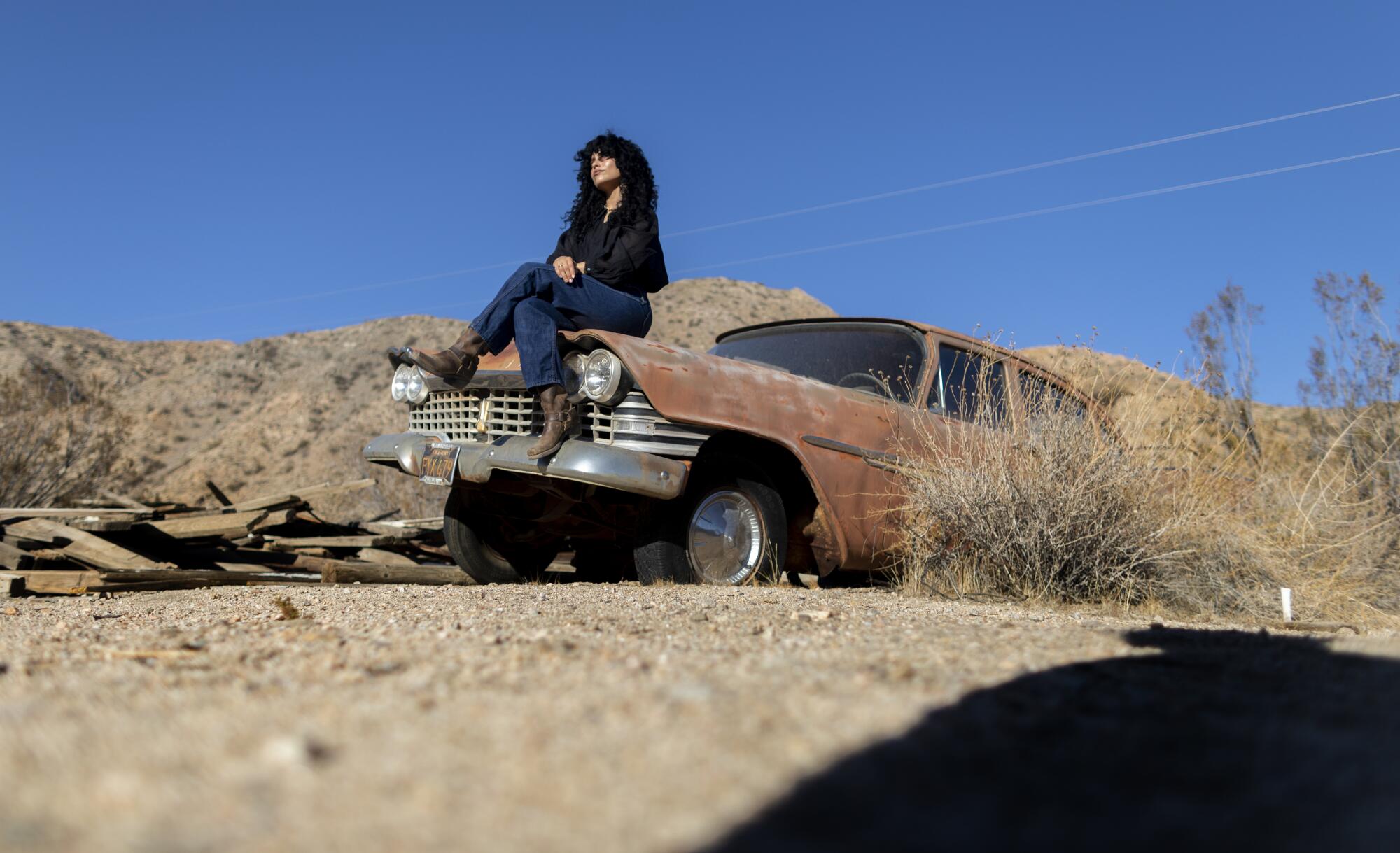
About 20 minutes away, just beyond the border of Yucca Valley, Evanice Holz relished the isolation the desert lifestyle offers. She left her Silver Lake studio and moved to a remote casita summer of last year, after feeling that the pandemic stripped away the connections tethering her to her hometown. Before the virus hit, she would regularly come to the Joshua Tree area to unwind; it seemed like a natural fit for her new home.
“I wanted someplace where I could enjoy nature, where I could enjoy space. I felt really claustrophobic,” said Holz, founder of the catering company Señoreata, specializing in plant-based Cuban cuisine. “I was one of the folks during the pandemic who really didn’t leave their house unless there was a dire need.”
She found the desert home, which has three bedrooms and a greenhouse, a few days into her search for a new place. She moved in within two weeks and brought her business with her. She worked on pickup orders in both L.A. and the high desert throughout the pandemic, later offering catering services at events such as weddings and baby showers in the desert, while also spending weekends in L.A. selling her food at the open-air market Smorgasburg when it reopened.
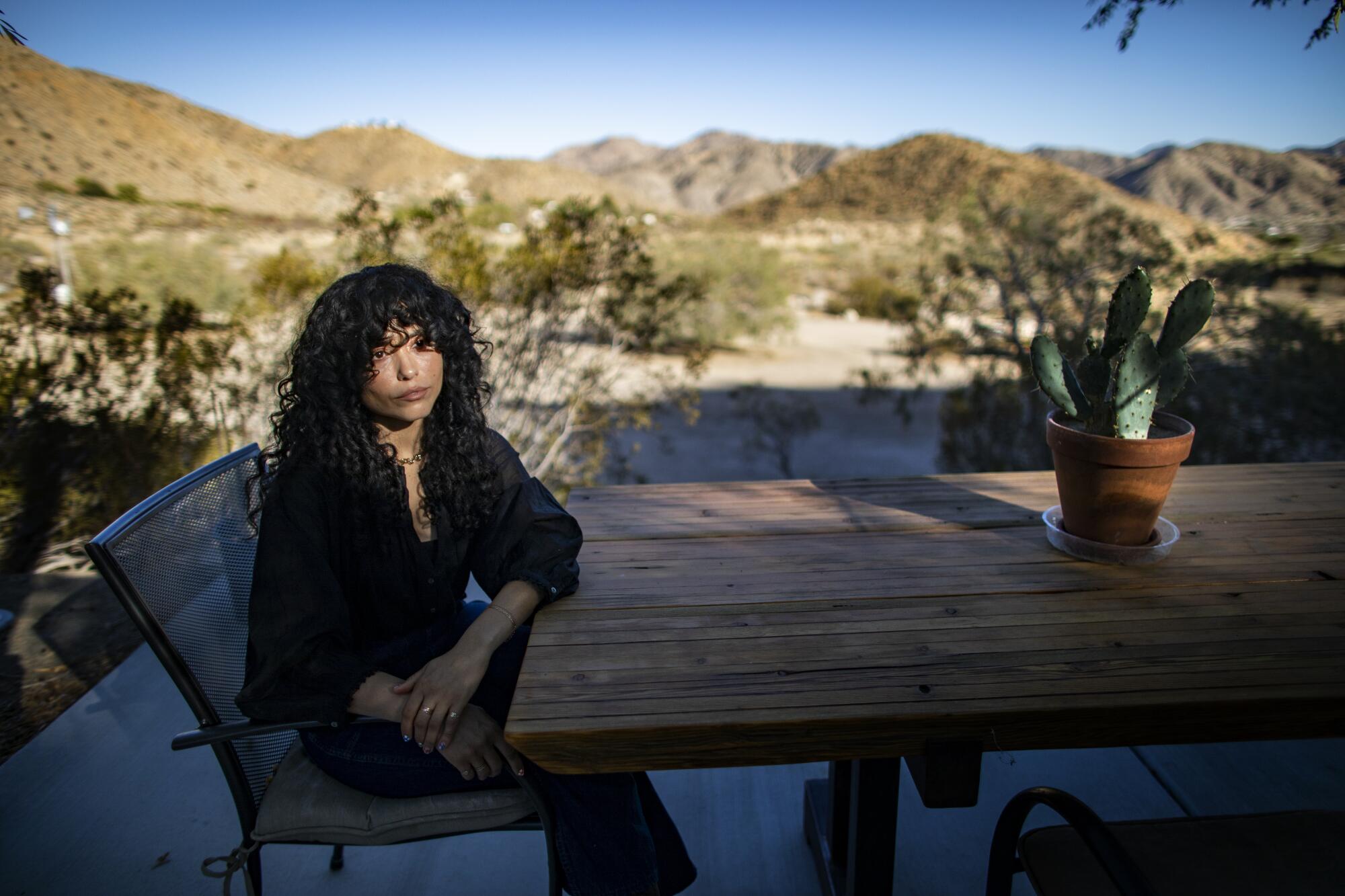
Sitting at her outdoor dining table atop a hill with sweeping views of the rugged terrain, the 33-year-old said she feels at peace hiking the trails within walking distance of her house and growing the vegetables and herbs on the property.
“I paid about $1,600 [a month] for a studio in Silver Lake. Here, I pay less than that for over an acre of land,” she said. “The solitude really helps me appreciate everything and not be susceptible to burning out like I was in L.A., because there’s a nice balance between city life and desert calm.”
Living in the desert has made the stress of her old life clear. Here, she said, she is content to wake up with the sun every morning. The power outages that take out her well — and shower, as a result — don’t bother her much. Neither does the spotty internet.
And she’s picking up the local lingo.
“My landlord here speaks in different terminology. When I needed something repaired, he said, ‘I’ll be there when the shadow has left the front of your house,’” she said, laughing. “There have been logistical and cultural things to get used to.”

When business picked back up and she was able to set up as a vendor in L.A., Holz said, she felt a moment of anxiety. She wasn’t sure if she could make her new life in the desert sync with her city job. She worried she would have to move back. But one month into living in the desert and working in the city on weekends, she realized she had to hold on to what she’d found.
“This whole thing has showed me what really matters,” she said, “which is enjoying the short time you have here — wherever you want to go.”
This is the second in an occasional series about Californians on the move, both to other states and within the Golden State.
Read more from this series
The surge of migration eastward fits a pattern of families escaping densely populated cities, a trend that dates back to the mid-20th century.
More to Read
Sign up for Essential California
The most important California stories and recommendations in your inbox every morning.
You may occasionally receive promotional content from the Los Angeles Times.

